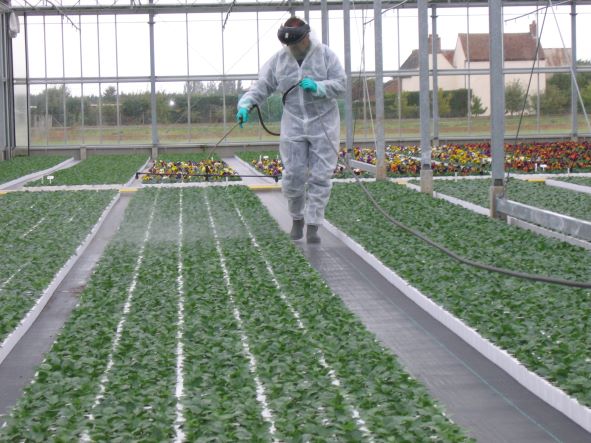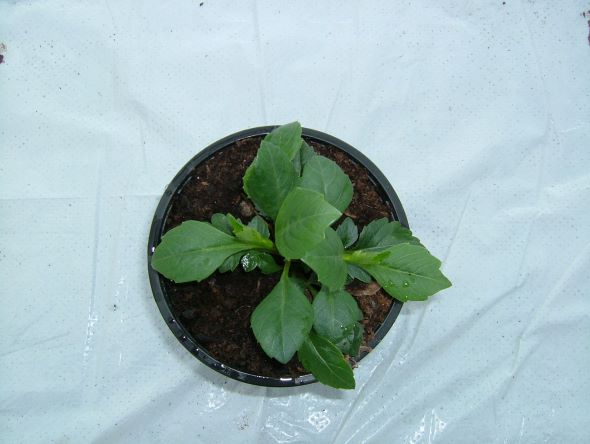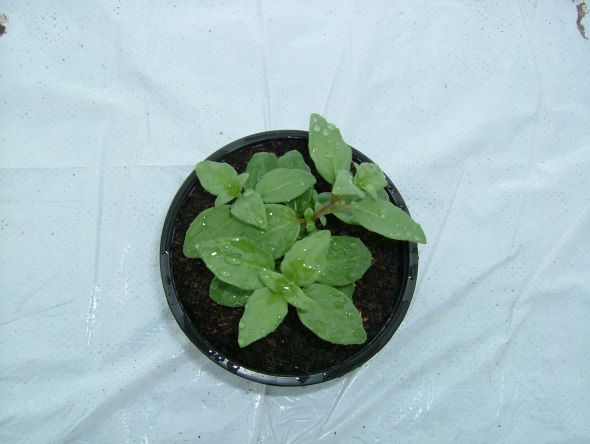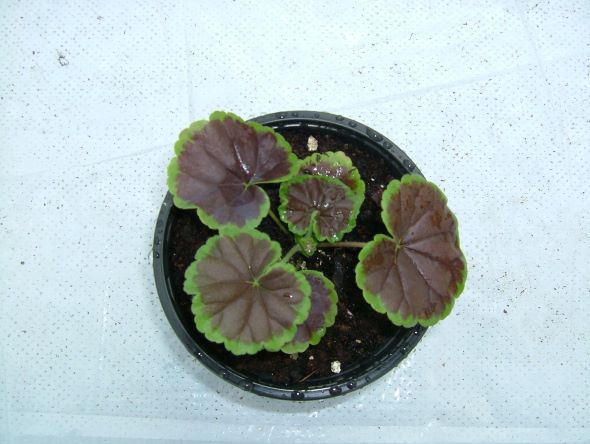Please click here to access the main AHDB website and other sectors.
- Home
- Knowledge library
- Chemical plant growth regulators - application
Chemical plant growth regulators - application
Applications of chemical plant growth regulators (PGRs) should be made at the appropriate growth stage and via the recommended method to achieve the desired effect.
PGR applications need to be planned to ensure that plant subjects are in an appropriate condition for safe, effective treatment.
- PGRs should be applied to established, well-watered plants with dry foliage under dull weather conditions and in high humidity
- PGRs should not be applied to plants that are pot bound, under water, nutrient or any other type of stress
- Treatments should not be made in bright sunlight to avoid the risk of phytotoxicity
To ensure that any growth regulatory effects can be reproduced and that the causes of any issues that may arise can be easily determined, maintain detailed records of applications including dose rates, plant species, growth stage and environmental conditions. Determine the effectiveness of treatments by recording crop development and leave a few plants untreated for comparison.
Refer to appropriate product labels/technical information or EAMUs prior to application to determine the relevant or maximum dose rate, frequency of application, water volume and crop specific information for the product being applied.
Uniform and repeatable applications of PGRs are essential for whole crop growth control

Courtesy and copyright of ADAS Horticulture.
Timing
PGR applications should be made at the appropriate growth stage for the plant species and variety, and the crop’s physiological condition such as leaf number, plant size or side shoot development. If applied too soon, plant growth may stop completely rather than be controlled in a balanced way. Conversely, late application can result in two distinctive levels of plant habit, delayed flowering and reduced flower size, or reduced bract size and delayed bract colour development in the case of poinsettia.
To maximise their effect, PGRs should be applied to new growth prior to any rapid stem extension or at the very first signs of flower bud initiation stage when the objective is to reduce flower stem length.
PGRs are normally applied as repeated, low rate treatments as this allows applications to be fine-tuned to growing conditions. When applied every 7–14 days a 15–30% reduction in plant height can be achieved. Alternatively, a single high rate application can be made, but this approach carries more risk and can be excessive under cool, dull conditions. Plants tend to return to their normal growth rates within two to four weeks after foliar application of PGRs.
To ensure maximum efficacy of PGRs, they should be applied late in the afternoon or early in the evening to prevent rapid evaporation from the leaf surface and to allow the chemical to be absorbed slowly by the plant overnight. The use of shade screens can also help to prevent evaporation of the applied product prior to leaf uptake and avoid scorch where bright conditions continue post application.
PGRs should be applied at the correct plant growth stage, before rapid extension: (a) Dahlia

(b) Fuchsia

(c) Geranium

Courtesy and copyright of ADAS Horticulture.
Application method
PGRs can be applied either as sprays or drenches, depending on their mode of action. Although spray applications tend to have less impact on plant growth compared to drenches, they are easier to fine-tune through repeat applications. Spray applications are also less expensive to apply than drenches due to the lower labour costs involved.
Foliar sprays
Foliar sprays require even application for consistent, uniform results. This is best achieved by applying a known water volume and product rate to a determined area for reproducible results. Fine spray droplets generally achieve better coverage and canopy penetration. Spray run-off should be avoided as it is wasteful and can result in too strong an effect from root uptake. Such run-off can also contribute to some products building up in capillary matting contributing to unwanted growth regulation in subsequent crops.
Special care must be taken when applying paclobutrazol. Low spray volumes may result in poor coverage, insufficient growth control and increased variability within the crop. Conversely applying too high a spray volume can result in spray running into the growing medium where it can have a persistent effect.
Care should be taken to avoid root uptake when treating plugs or recently potted crops with a large exposed surface area of growing medium, by delaying application until the plant’s foliage has covered some of the surface. Too high a rate or volume can also effectively stop plant growth, which can render crops unsaleable, particularly young plants, early on in the production phase.
In general, irrigation should not be applied for 24 hours post application, although label recommendations are for shorter time periods for Stablian 750 (12–18 hours) and Cerone (rain-fast within 4–6 hours).
Drench application
Although time consuming, drenches are easier to apply evenly than foliar sprays providing there is adequate, evenly distributed moisture within the growing medium. Drenches are applied by volume, depending on pot size. Drenches should be applied when roots are actively growing to enable uptake. Wash any excess growth regulator off the leaves to avoid chlorosis.
PGRs with root activity are generally more potent when applied to the growing medium as a drench than as a foliar spray. For drench applications, avoid irrigating crops too soon after application. A drop in temperature post application (spray or drench) can also enhance the effect of the PGR, resulting in a more powerful reduction in growth.
Adjuvants
In the case of Stabilan 750 use of a non-ionic wetter is recommended with to minimise leaf chlorosis. For products containing daminozide and paclobutrazol the label states that they should not be mixed with other chemicals, including adjuvants.
Adjuvants such as Elasto G5 (glycerol/fatty acid polymer) can give improved uptake of products containing chlormequat and daminozide allowing PGR rates used to be reduced without impacting the crop response.
Dose rate calculations
Rates of plant growth regulators are sometimes given in parts per million (ppm). The correct quantity of product, based on active ingredient ppm, can be calculated as follows:
Bonzi (4%)
To calculate 50 ppm active ingredient (ai):
50 ppm ai = 50/4 x 100 = 1,250 ppm commercial product.
To convert to ml/litre:
1,250/1,000 = 1.25 ml product /litre.
Stabilan 750 (75%)
To calculate 250 ppm active ingredient (ai):
250 ppm ai = 250/75 x 100 = 333.3 ppm commercial product.
To convert to ml/litre:
333.3/1,000 = 0.33 ml product/litre.
(Note the maximum legal rate of 0.5 ml/L on the EAMU must not be exceeded).
Plant species
Different plant species and varieties can vary in their response to the different PGR active ingredients. Therefore it is necessary to identify which plants respond to which active ingredients and determine the appropriate application rate to obtain optimum results; rates may have to be adjusted even between varieties.
Growers should be cautious when interpreting results from overseas as the climate and growing conditions can be very different from the UK. Rates from the southern states of the USA, for example, should not be considered as they may be too high, resulting in excessive growth regulation when used in the UK.
Plant specific information can be found on product labels, EAMUs and company technical information. Table 10 summarises which PGRs have been effective on which plant species, the information presented is derived from a number of sources.
Table 10. Summary of responsive plant species by PGR active ingredient
| Chlormequat | Daminozide | Ethephon | Ethephon + mepiquat chloride | Paclobutrazol | Prohexadione | Prohexadione-calcium + mepiquat chloride |
Trinexapac-ethyl |
| Stabilan 750 | B-Nine SG Dazide Enhance Stature | Cerone | Terpal | Bonzi Pirouette | Regalis Plus | Canopy | Moddus Primo Maxx II |
| Achillea | Alyssum | Achillea | Begonia | Achillea | Achillea | Cosmos* | Achillea |
| Ageratum | Ageratum | Begonia | Dianthus | Ageratum | Ageratum | Dianthus | Begonia |
| Antirrhinum | Antirrhinum | Dahlia | Geranium | Alyssum | Begonia | Tagetes* | Dianthus* |
| Celosia | Aster | Dianthus | Impatiens | Begonia | Bidens | Fuchsia | |
| Coreopsis | Azalea | Fuchsia | Osteospermum | Campanula | Coreopsis | Geranium | |
| Diascia | Brassica | Geranium | Pansy | Celosia | Dahlia | Impatiens | |
| Erysium | Chrysanthemum | Impatiens | Poinsettia | Chrysanthemum | Dianthus | Osteospermum | |
| Geranium | Coleus | Lantana | Tagetes* | Cineraria | Diascia | Petunia | |
| Impatiens | Coreopsis | Pelargonium | Zantedeschia | Coreopsis | Dicentra | Salvia | |
| Lavatera | Cosmos | Petunia | Cosmos* | Fuchsia | Tagetes* | ||
| Lobelia | Dahlia | Tagetes | Dahlia | Geranium | |||
| Mimulus | Diascia | Verbena | Dianthus | Impatiens | |||
| Osteospermum | Dicentra | Diascia | Osteospermum | ||||
| Pansy | Fuchsia | Fuchsia | Petunia | ||||
| Pelargonium | Geranium | Geranium | Salvia | ||||
| Phlox | Hydrangea | Impatiens | Tagetes | ||||
| Poinsettia | Impatiens | Kalanchoe | Verbena | ||||
| Salvia | Lobelia | Leucanthemum | |||||
| Stocks | Mesembryanthemum | Lobelia | |||||
| Verbena | Nasturtium | Mesembryanthemum | |||||
| Wallflower | Nemesia | Nemesia | |||||
| Nicotiana | N. Guinea Impatiens | ||||||
| Pansy | Osteospermum | ||||||
| Pelargonium | Pansy | ||||||
| Petunia | Petunia | ||||||
| Phlox | Pholx | ||||||
| Salvia | Phygelius | ||||||
| Sunflower | Poinsettia | ||||||
| Sweet pea | Rosa | ||||||
| Tagetes* | Salvia | ||||||
| Verbena | Stocks | ||||||
| Viola | Tagetes | ||||||
| Zinnia | Verbena |
This information has been gathered from product labels, approval notices, ADAS Technical Sheet P3151, AHDB projects PO 004, 019a, 019b and HNS 103b (refer to the reports for more detailed information on varieties and rates used).
* These products were effective when used as plug drenches at cotyledon stage.
Useful links
For further general information on spray application, follow the link below:
Authors
Authors – Chloe Whiteside, Jill England and David Talbot. ADAS Horticulture.
Original authors – Jill England and David Talbot. ADAS Horticulture.
Webpage content correct as of May 2021.
Topics:
Sectors:
Tags:

